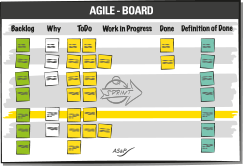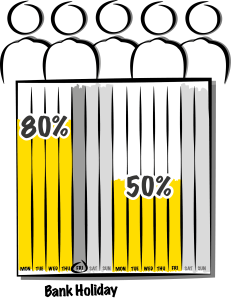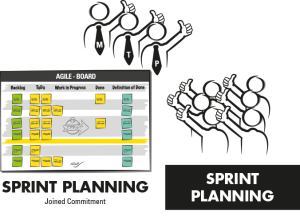
Phase 1: The impulse from the POT to the team.
At the beginning of a sprint cycle, the POT presents the team with the pre-planned product backlog list from the previously held conclave. The team asks questions such as: “What is meant by this backlog item?”, “What makes you think that this backlog item has the same size as the others?”, “Should the documentation also be included?”, “Have you thought about the functional safety check?”.
In order to estimate the effort of individual backlog items, it has proven useful to give each item a clothing size (S, M, L, XXL), for example. It is also common to evaluate with numbers according to the Fibonacci sequence (1, 2, 3, 5, 8, 13 …, each number corresponds to the sum of the two preceding numbers) or with the help of planning poker: The team members evaluate the complexity of individual backlog items with the help of playing cards, concealed and independently of each other.
With the help of these assessments, misunderstandings about the actual task or completely different assessments of the development effort required for it can be uncovered.
Finally, new backlog items are written that may simply have been forgotten by the POT. The important thing for the start is to just get started. The refinement of the method can be tried out in each subsequent sprint.
No sprint start without team commitment.
The main point here is to make step 1 of good leadership – you remember: “Set clear goals” – concretely better. An AGILECOACH moderates this discussion so that the POT takes the team’s questions and criticism as constructive advice and corrects the POT’s blue cards. Otherwise, there is a risk that the team’s commitment to the results wish list will suffer.
Many a POT member is used to giving the team prepared and well thought-out targets and then saying goodbye. Correcting or changing these targets is taken as criticism and disrespect. Of course, something also goes wrong if nothing remains of the prepared backlog list after the team discussion. The AGILECOACH moderates this balance.
At the end of the sprint planning there is a common list accepted by POT and team – that is the decisive goal.

Phase 2: Capacity planning – “and, can you do it?”
After the first phase, the backlog list of the POT has changed due to the team’s input. Looking at the corrected backlog list together, the AGILECOACH asks the next crucial question to the team: “So, can you do it?”
This may sound banal, but in practice the explicit preoccupation with the available implementation capacity is often suppressed. In industrial reality, the ideal condition of team members being 100% assigned to the project is rarely found.
The team member has only one project: this is ideal, but is often unrealistic.
When asked by the AGILECOACH about available capacity, each team member checks their calendar and looks at the next ten days. Individuals will say, “In the second week I only have 50% capacity for this project, plus the first week has a holiday. On average, I needed 20% time per day to answer questions from product management, production, suppliers, etc.”. Accordingly, out of ten days, there are net four days left.” For another team member it might be six, for the next five days and so on. Adding it all up gives the group capacity.

Phase 3: “The yellow line”.

The culmination of each sprint cycle is approaching: Against the backdrop of this group capacity and in the face of the new backlog list, the AGILECOACH hands the team the yellow fibre pen from the AGILESET case. With the yellow pen, a team member steps up to the AGILEBOARD and draws a line dividing the backlog list, for example, so that of the 15 backlog items, three are below the yellow line.
And while doing so, speaks the magic words:
“If things go well, we’ll get those three backlog items below the yellow line done!”
When a dominant POT member hears these words for the first time, he may have to gulp or take out his heart drops. It sounds like sabotage and refusal to work, the team refuses to implement! Other POT members may think, “This is not how I imagined it with this AGILE, it was better before! I want to go back!”.

He who does not have the courage to say no, his yes has no value!
(Quote Kurt Schumacher).
What are the advantages of this yellow line?
1. the team became aware of what is possible in the time available. This increases the likelihood of avoiding disappointment.
2. the team can focus on a scope they think is possible and free themselves from a paralysing overload (“we don’t even need to start, we can’t do it anyway!”).
3. the team has visibly and physically (the yellow fibre pen) taken the helm. This symbolic act manifests and realises the goal of Agile:
Self-determination in the team.
4. the team committed the backlog items above the yellow line.
5. the team constrained with “if it goes well”. So it could also be that the team is “overperforming“. And how could over-performance be visible without this yellow line?
6. the POT can focus. “Above the line, the team has committed – below the line, that is our job!”
7. the POT can decide on the backlog items below the yellow line:
Because every fortnight, goals that have ended up at the bottom of the ranking after a previous prioritisation are deleted. This is completely new. It feels weird at first. Omit? Yes, omit! Against the background that everything else is more important and the team cannot take on the commitment for this because they lack the capacity, less is more.
Less is more.
And we don’t mean the main functionalities of the product. We distinguish between the Product Backlog and the Sprint Backlog. The Product Backlog corresponds to the specifications. In it, the decisive, competition-relevant main functionalities of the product are defined as requirements. They are not the subject of discussion every fortnight!
The question is rather whether the implementation of the requirements can be achieved with higher or lower complexity. Even more important are the questions:
Will the customer honour this – does he even see it?
How can the maximum result be achieved with the available capacity?

Phase 4: The Thumbs-up Ritual.
When this exercise is completed, the culmination of the joint sprint planning is concluded with a symbolic ritual. All team members and the members of the POT seal the agreement on the work content of the upcoming two-week sprint by all looking into each other’s eyes for a moment, giving a thumbs-up, and non-verbally asking each other if everyone is really on board: here and now is the last opportunity to express objections, concerns or doubts.
If everyone gives the thumbs up, each team member can assume that every other team member will be as committed to the sprint goal as they are.
Furthermore, the team’s questioning look in the POT’s eyes seeks reassurance that they will not be confronted with changes or completely new goals on Wednesday.
 After this thumbs-up ritual, step 2 of good governance begins: Let freedom!
After this thumbs-up ritual, step 2 of good governance begins: Let freedom!
Because that is the genius of AGILE: the most difficult step of good leadership, freedom, is an integral part of the sprint. This aspect can no longer be unconsciously forgotten. The sprint is freedom in the team. And it starts now. From now on, the team is completely on its own. The POT leaves the room, the door slams shut and the team takes a deep breath. Can you relate to the feeling of the team members?
A mixture of “Yay, finally alone” and utmost concentration. After all, the team has made a promise. In a fortnight, they want to have worked through the backlog list. And maybe even more.

Phase 5: The TEAMAGILEBOARD
The gift of freedom comes with the obligation to organise oneself. This involves the team setting up an AGILE board for itself, just like the POT. On this TEAM AGILE BOARD, the backlog items with the POT’s desired results (blue cards) are broken down in a ratio of 1:n into activities that are necessary to achieve the sprint goal.
The team uses the yellow cards to do this. All this happens without the POT, because the TEAMAGILEBOARD represents the team’s privacy, where no POT member has any business. The only person who is allowed to be there is the AGILECOACH.
The aim of this TEAMAGILEBOARD is the maximum development of personal responsibility within the team. This means that the team learns to organise itself. Only then can and will it take full responsibility for what it sets out to do.